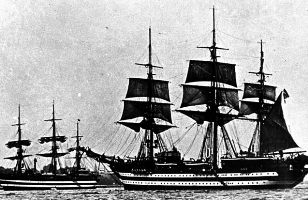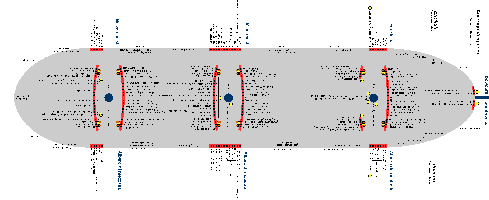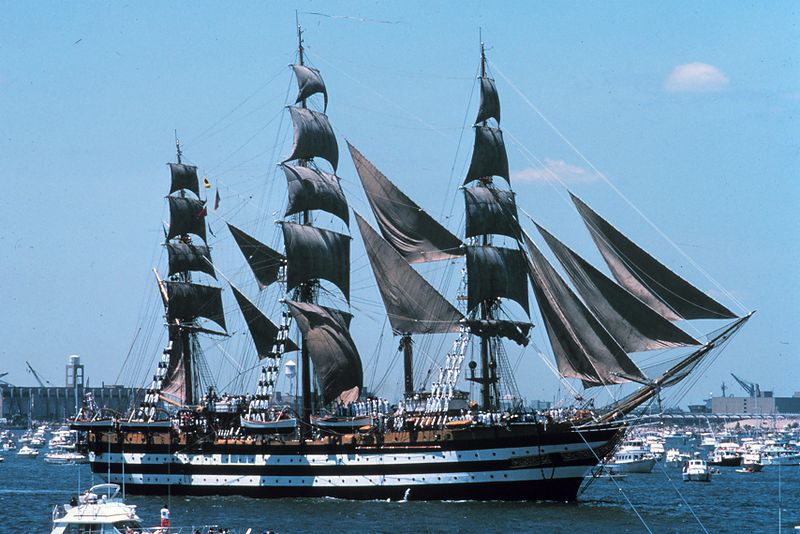Data
| Type/Class:
|
Dimensions:
|
Decks:
|
Armament:
|
Rigging:
|
Crew:
|
| Italian Training Ship
|
Total Length: 101m
Width: 15,5m
Height (main mast): 54m
|
Stepped Deck
|
none
|
3 masted full rigger
5-5-5 yards (fore-main-mizzen, after 1976)
4-4-4 yards (fore-main-mizzen, before 1976)
staysails, optional studding sails
26 sails
Sail area: 2824sqm
|
max. 450 men
|
[From Wikipedia:] The hull is painted black with two white stripes in reference to the two gun decks of the original ships the design is based on, but she carries only two 6pdr saluting guns in pivot mountings on the deck, forward of the mainmast. The deck planks are of teak wood and must be replaced every three years. Bow and stern are decorated with intricate ornaments; she has a life-size figurehead of Amerigo Vespucci. The stern gallery is accessible only through the Captain's salon.
When carrying cadets, the ship is usually steered from the manual stern rudder station, which is operated by four steering wheels with two men each. At other times, the hydraulically assisted steering on the bridge is used. Except for the anchor winch, the winches aboard are not power operated. The bridge is equipped with sophisticated modern electronic navigation instruments.
Except for the time during the second World War, the Amerigo Vespucci has been continually active. Most of her training cruises are in European waters, but she has also sailed to North and South America, and navigated the Pacific. In 2002, she undertook a voyage around the world.
The Amerigo Vespucci often takes part in sailing parades and Tall Ships' Races, where she is in amicable rivalry with the Gorch Fock. When she is berthed in port, public tours of the vessel are usually offered.
History
1931 built in Naples as the second ship of the "Rotundi" class (the first was the "Cristoforo Colombo", 1928-1943, eventually scrapped in Russia around 1950) for the Regia Marina.

The Amerigo Vespucci before WW2. With a pause of the war, she served continuously as a training ship for the Italian Navy, until today.
My Personal History with the Amerigo Vespucci
1977: I was a 10 year old boy growing up in Germany (cannot remember any time when I was NOT fascinated by sailing ships).
The Amerigo sailed to Hamburg and had Open Ship for the Public between the 5-9 of August 1977.
I wrote a naive letter to the captain (how the heck did I get the address?) - but he invited me as a special guest!
So I saw the ship with my own eyes for the first time in my life,
receiving an extra guided tour - in German! -,by the cadet Giovanni Milo (would like to know what became of him).
He showed me the rigging and the captains cabin, and I felt very lucky to be onboard. Since then, the Amerigo Vespucci has always been in my mind ...
but I lost contact and for a long time, there was no way for me to see the ship again ...
2005: after a long period, and many turns in my life, I had another rare chance again to visit the Amerigo Vespucci in Bremerhaven, at the Sail 2005.
But I had only a small old camera and all
the shots were already spent, so I made hand notes and drawings; but the ship was closed before I finished, so I had to wait for the next time ...
Meanwhile I ordered the Amerigo model kit from Heller and started building the hull.
2010: Sail 2010 in Bremerhaven again. This time I was prepared: I learned some Italian phrases ("Scusi, parli Inglese?") and trained maritime terms in Italian, using my own
Maritime Dictionary (in the menu above). I studied all pictures I had of the ship, mostly in some books in my library, or from the internet,
and prepared some drawings of the rigging. And I had a better camera with 2 zoom lenses, 2 fresh batteries and 2 big memory cards to make thousands of pictures in Bermerhaven:)
Onboard, I met with Fabrizio Lecce, an officer who was so kind to answer all my questions that I had for so many years.
Sources for Research
The ship in itself :) She is sailing to many harbours, and there she is open for visitors, representing the Italian Navy.
Making photos is allowed - so I made hundreds of pictures in Bremerhaven Sail 2010.
You can talk to the officers (try some Italian first, it will open the doors:) and they will help You.
|
Books
I really wonder why there are no dedicated books available about the SHIP - instead, there are masses of books about the famous discoverer .... I maybe I do not know and they are all in Italian only ... and I also wonder why the English speaking world has such a huge output of books, whereas books about navgiation in mediterranian languages are so little ...
Reconstructions for a Model of the Amerigo Vespucci
This ship is so extraordinary beautiful that literally thousands of models have been built and are still being built all over the world.
You can even buy masses of Amerigo-alike lower quality souveneer ships in many harbours of the world.
Depending on the desired quality of the model, You may put as much effort in it as You like. Although I am "only"
about to build a plastic kit model (the Heller kit), which could be considered the Second League of Modellers,
still the rigging is the eye catcher, and so I spend much time (30 years in my case, but that is extreme ...) to study the original rigging. Yes, the hull
and the structures are complicated, too, but the true challenge always is the rigging:
The Rigging
The Amerigo Vespucci has a typical full rigging of the 19th century; it changed in 1976 after a rerigging from 4 to 5 yards per mast:
5 yards on all 3 masts; a 6th yard can be set, too, in light weather. NOTE: all sails have individual names, very different from English!
- Fore Mast = Albero di Trinchetto
- Fore Royal = Controvelaccino
- Fore Topgallant = Velaccino
- Fore Upper Topsail = Parocchetto volante
- Fore Lower Topsail = Parocchetto fisso
- Fore Course = Trevo Trinchetto
- Main Mast = Albero di Maestra
- Main Royal = Controvelaccio
- Main Topgallant = Velaccio
- Main Upper Topsail = Gabbia volante
- Main Lower Topsail = Gabbia fissa
- Main Course = Trevo Maestra
- Mizzen/Jigger Mast = Albero di Mezzana
- Mizzen Royal = Controbelvedere
- Mizzen Topgallant = Belvedere
- Mizzen Upper Topsail = Contromezzana volante
- Mizzen Lower Topsail = Contromezzana fissa
- Crossjack = Mezzana
- Spanker = Randa
Before 1976, it was:
- Fore Mast = Albero di Trinchetto
- Fore Topgallant = Velaccino
- Fore Upper Topsail = Parocchetto volante
- Fore Lower Topsail = Parocchetto fisso
- Fore Course = Trevo Trinchetto
- Main Mast = Albero di Maestra
- Main Topgallant = Velaccio
- Main Upper Topsail = Gabbia volante
- Main Lower Topsail = Gabbia fissa
- Main Course = Trevo Maestra
- Mizzen/Jigger Mast = Albero di Mezzana
- Mizzen Topgallant = Belvedere
- Mizzen Upper Topsail = Contromezzana volante
- Mizzen Lower Topsail = Contromezzana fissa
- Crossjack = Mezzana
- Spanker = Randa
1 spanker on the mizzen mast
2 staysails each between fore-main and main-mizzen
4-5 staysails on the bowsprit
extra studding sails ("coltelazzi") can be set from a outrigger boom on the lower yards
|
The Standing Rigging
|
|
Bowsprit - Fore Mast
|
Fore Mast - Main Mast
|
Main Mast - Mizzen Mast
|
Mizzen Mast
|
Topgallant Mast
|
|
- 2 shrouds (rear side)
- 1 stay
- 4 backstays
|
- 2 shrouds (rear side)
- 1 stay
- 4 backstays
|
- 2 shrouds (rear side)
- 1 stay
- 2 backstays
|
Topmast
|
|
- 4 shrouds
- 3 topstays
- 5 backstays
|
- 4 shrouds
- 2 stays
- 5 backstays
|
- 4 shrouds
- 2 stays
- 2 backstays
|
Lower Mast
|
|
|
|
|
The Running Rigging
Belaying Positions

|
This is my own plan that I made from my notes at the Sail 2010 in Bremerhaven;
in English(left half) and Italian(right half), 90% of the ropes are symmetric on port and starboard.
A short extract from my dictionary, English-Italian:
- Mast = Albero
- Yard = Pennone
- Shroud = Sartia
- Backstay = Paterazzo
- Stay = straglio, strallo
- Halyard = Drizza
- Sheet = Scotta
- Tack = Amura
- Clewline = Caricascotta
- Leechline = Carica bolina
- Buntline = Caricamezzi
- Reef = Paranco di rollo (literally: tackle = paranco)
- Vang = Ostini
- Downhaul = Alabasso
- (Topping) Lift = Amantiglio
The layout of the bitts and the arrangement of the belayings are unique to the ship.
|
Sail 2010
Saturday, 2010-08-28
some best-of pictures from my visit at the Sail 2010 in Bremerhaven
The Heller model kit, Scale 1:150
For the plastic modeller, there is only this model kit available from Heller. And that is sold out ... I have one =)
|


